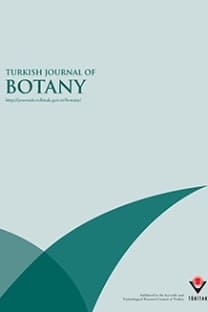The molecular characterization and expression analyses of ethylene receptor genes from watermelon fruit
Watermelon fruit is very sensitive to ethylene, showing rapid deterioration and water-soaking upon ethylene exposure. The objective of this study was to isolate and determine the expressions of ethylene receptor genes in watermelon fruit. As a result of PCR amplification of cDNAs obtained via RT-PCR of total RNA from watermelon fruit with degenerate primers, 3 partial cDNAs were obtained. After extension of the 3' and 5' ends of the cDNAs via 3' and 5' RACE analysis, 3 full-length genes designated as CL-ETR1, CL-ERS1, and CL-ETR2 were obtained. Upon cloning and sequencing, it was determined that the CL-ETR1, CL-ERS1, and CL-ETR2 genes were 2343, 2349, and 2550 bp in length, respectively. The structure and sequence analysis showed that the isolated genes had conserved domains found in previously isolated ETR genes. Southern blot analysis showed a single band for CL-ETR1 and CL-ETR2 and 2 bands for CL-ERS1. Northern blot analyses showed that the expression levels of all 3 receptor genes significantly increased during postharvest storage and in response to ethylene exposure. 1-Methylcyclopropene (1-MCP) treatment significantly reduced the expressions of all receptor genes. The genes also showed different expression patterns during fruit development. The isolated genes could be used in biotechnological studies to develop cultivars with altered ripening behavior that are more tolerant to ethylene-related physiological disorders such as water-soaking.
The molecular characterization and expression analyses of ethylene receptor genes from watermelon fruit
Watermelon fruit is very sensitive to ethylene, showing rapid deterioration and water-soaking upon ethylene exposure. The objective of this study was to isolate and determine the expressions of ethylene receptor genes in watermelon fruit. As a result of PCR amplification of cDNAs obtained via RT-PCR of total RNA from watermelon fruit with degenerate primers, 3 partial cDNAs were obtained. After extension of the 3' and 5' ends of the cDNAs via 3' and 5' RACE analysis, 3 full-length genes designated as CL-ETR1, CL-ERS1, and CL-ETR2 were obtained. Upon cloning and sequencing, it was determined that the CL-ETR1, CL-ERS1, and CL-ETR2 genes were 2343, 2349, and 2550 bp in length, respectively. The structure and sequence analysis showed that the isolated genes had conserved domains found in previously isolated ETR genes. Southern blot analysis showed a single band for CL-ETR1 and CL-ETR2 and 2 bands for CL-ERS1. Northern blot analyses showed that the expression levels of all 3 receptor genes significantly increased during postharvest storage and in response to ethylene exposure. 1-Methylcyclopropene (1-MCP) treatment significantly reduced the expressions of all receptor genes. The genes also showed different expression patterns during fruit development. The isolated genes could be used in biotechnological studies to develop cultivars with altered ripening behavior that are more tolerant to ethylene-related physiological disorders such as water-soaking.
